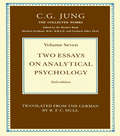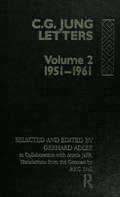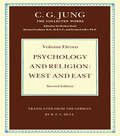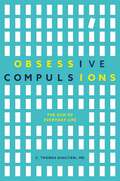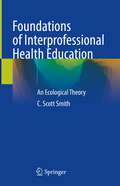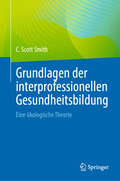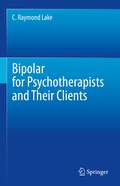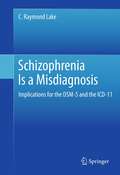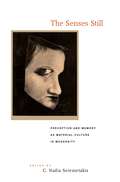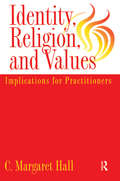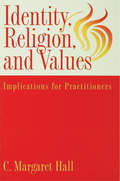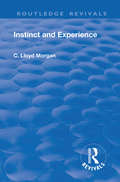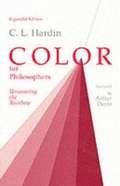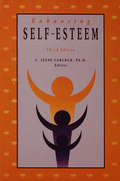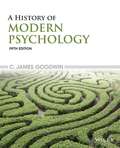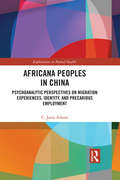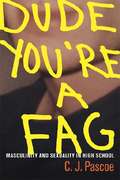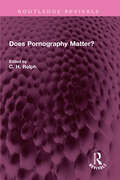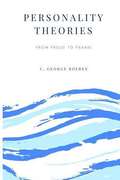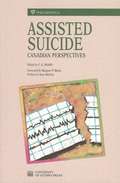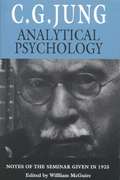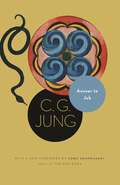- Table View
- List View
Two Essays on Analytical Psychology (Collected Works of C.G. Jung)
by C.G. JungThis volume from the Collected Works of C.G. Jung has become known as perhaps the best introduction to Jung's work. In these famous essays he presented the essential core of his system. This is the first paperback publication of this key work in its revised and augmented second edition. The earliest versions of the essays are included in an Appendices, containing as they do the first tentative formulations of Jung's concept of archetypes and the collective unconscious, as well as his germinating theory of types.
Letters of C. G. Jung: Volume 2, 1951-1961
by C.G JungIn May 1956, in his eighty-second year, Jung first discussed with Gerhard Adler the question of the publication of his letters. Over many years, Jung had often used the medium of letters to communicate his ideas to others and to clarify the interpretation of his work, quite apart from answering people who approached him with genuine problems of their own and simply corresponding with friends and colleagues. Many of his letters thus contain new creative ideas and provide a running commentary on his work.From some 1,600 letters written by Jung between the years 1906-1961, the editors have selected over 1,000. Volume 2 contains 460 letters written between 1951 and 1961, during the last years of Jung's life, when he was in contact with many people whose names are familiar to the English reader. These include Mircea Eliade, R.F.C. Hull, Ernest Jones, Herbert Read, J.B. Rhine, Upton Sinclair and Fr. Victor White.Volume 2 also contains an addenda with sixteen letters from the period 1915-1946 and a subject index to both volumes. The annotation throughout is detailed and authoritative.
Psychology and Religion Volume 11: West and East (Collected Works of C.G. Jung #50)
by C.G JungSixteen studies in religious phenomena, including Psychology and Religion and Answer to Job.
Obsessive Compulsions: The OCD of Everyday Life
by C. Thomas GualtieriAlmost everybody has an obsession or feels a compulsion to do something a certain way. Magic numbers, intrusive thoughts, unusual fears and superstitions happen to about four people out of five, but where do these obsessive-compulsive (OC) traits come from? This book explores what they are, why we have them and what we can do about them, through fascinating and highly original insights. Are you a perfectionist, or can you be fussy? Do you like to have control in certain situations? Or are you overly anxious in others? These are all OC traits, and this book looks at their recent increase in human behaviour, and how they are formed in the brain. Showing that these traits are more common in highly educated, intelligent and successful people, it highlights the positive sides of what have previously been seen as negative quirks. Weaving together sections that are anecdotal and humorous, with technical and up-to-date scientific information, this groundbreaking book gives a fascinating introduction into an under-discussed personality type.
Foundations of Interprofessional Health Education: An Ecological Theory
by C. Scott SmithThis book is designed to introduce a theory of ecological psychology into interprofessional health education. The foundations are affordances (features in the environment that afford the opportunity to be recognized and utilized), the life-world (what the meaningful environment contains for the trainee), and behavioral-settings (person-made affordances that are permissive, supportive, or resistive to specific behaviors). Expanding the life-world is the main mechanism of learning in health care. Becoming aware of intentional and unintentional features of the behavioral setting is how we structure the curricular environment to achieve this life-world expansion. The book is structured into four domains: The Natural Domain, The Mental Domain, The Social Domain, and Non-Linearity. The final application section lays out a structure for designing, implementing, and evaluating the educational program in a professional healthcare setting. This book is ideal for clinician managers of interprofessional healthcare clinics, and for the teachers and trainees from each discipline (e.g., medicine, nursing, pharmacy, psychology, social work, etc.).
Grundlagen der interprofessionellen Gesundheitsbildung: Eine ökologische Theorie
by C. Scott SmithDieses Buch führt in eine Theorie der ökologischen Psychologie innerhalb der interprofessionelle Gesundheitsbildung ein. Die Grundlagen sind Affordanzen (Merkmale der Umgebung, die die Möglichkeit bieten, erkannt und genutzt zu werden), die Lebenswelt (was die bedeutungsvolle Umgebung für den Lernenden enthält) und Verhaltenssettings (von Menschen geschaffene Affordanzen, die spezifische Verhaltensweisen erlauben, unterstützen oder dagegenwirken). Die Erweiterung der Lebenswelt ist der Hauptmechanismus des Lernens im Gesundheitswesen. Das Bewusstsein für absichtliche und unbeabsichtigte Merkmale des Verhaltenssettings hilft uns, die curriculare Umgebung zu strukturieren, um diese Erweiterung der Lebenswelt zu erreichen. Das Buch ist in vier Aspekte unterteilt: der natürliche Aspekt, der mentale Aspekt, der soziale Aspekt und die Nichtlinearität. Der abschließende Anwendungsteil bietet eine Struktur für die Gestaltung, Implementierung und Evaluation des Bildungsprogramms in einem professionellen Gesundheitsumfeld. Dieses Buch ist ideal für Gesundheitsmanager interprofessioneller Gesundheitseinrichtungen sowie für Lehrende und Studierende aus verschiedenen Disziplinen, z. B. Medizin, Pflege, Pharmazie, Psychologie, Sozialarbeit.
Bipolar for Psychotherapists and Their Clients
by C. Raymond LakeThis unique book is needed because it aims to improve the care of Bipolar clients while strengthening the clinical practices of non-MD psychotherapists. What is different is the proposal that psychotherapists manage the overall care of Bipolar clients. The increased number of publications about Bipolar over the past decades has enhanced the recognition of Bipolar. As many as 16 million individuals in the US may have a Bipolar episode at some point.Psychiatrists have traditionally managed Bipolar clients but there are not enough psychiatrists and they generally spend only 10 to 15 minutes every one to six months with their clients—often not enough time to recognize oncoming Bipolar episodes. Therapeutic strategy has changed from treating acute episodes to postponing next episodes. Psychotherapists see their clients for 50 minutes every week and are in a better position to recognize developing episodes. Psychotherapists do not prescribe and medicines are usually needed along with psychotherapy for best results. This book encourages psychotherapists to vet and collaborate with prescribers in caring for the therapists’ Bipolar clients.Lacking in the psychotherapists’ armamentarium for treating Bipolar clients is education regarding diagnostic signs, symptoms, and treatment including the most productive medications. This book provides therapists and clients the needed information and encourages academic departments and other psychotherapy programs to institute training about Bipolar Disorders.
Schizophrenia Is a Misdiagnosis
by C. Raymond LakeSchizophrenia is the most widely known and feared mental illness worldwide, yet a rapidly growing literature from a broad spectrum of basic and clinical disciplines, especially epidemiology and molecular genetics, suggests that schizophrenia is the same condition as a psychotic bipolar disorder and does not exist as a separate disease. The goal is to document and interpret these data to justify eliminating the diagnosis of schizophrenia from the nomenclature. The author reviews the changing diagnostic concepts of schizophrenia and bipolar disorder with a historical perspective to clarify how the current conflict over explanations for psychosis has arisen. That two disorders, schizophrenia and bipolar, known as the Kraepelinian dichotomy, account for the functional psychoses has been a cornerstone of Psychiatry for over 100 years, but is questioned because of substantial similarities and overlap between these two disorders. Literature in the field demonstrates that psychotic patients are frequently misdiagnosed as suffering from the disease called schizophrenia when they suffer from a psychotic mood disorder. Such patients, their families, and their caretakers suffer significant disadvantages from the misdiagnosis. Psychotic patients misdiagnosed with schizophrenia receive substandard care regarding their medications, thus allowing their bipolar conditions to worsen. Other adverse effects are substantial and will be included. Liability for medical malpractice is of critical importance for the mental health professionals who make the majority of the diagnoses of schizophrenia. The concept put forward in this work will have a discipline-altering impact.
End-Stage Dementia Care: A Basic Guide
by C. R. KovachPeople with mid-stage dementia are served by special care units in long-term care facilities, although as these residents deteriorate, they are transferred out of the unit and into a general nursing home unit. These nursing homes are not equipped to deal with palliative needs of end-stage dementia care. The book addresses those needs. With this in mind, Part One examines the stages of dementia end-stage in particular. Other chapters in this section provide background on the hospice movement and hospice concepts; the idea of maintaining personhood; and administration of a late-stage care unit. Part Two focuses on treatment approaches for common needs in end-stage dementia - medical and physical care; a supportive environment; the fundamentals of care; psychopharmacology; and therapeutic activities. Part 3 contains chapters on family-centred care; legal and ethical issues; programme evaluation; and future opportunities.
The Senses Still: Perception and Memory as Material Culture in Modernity
by C. Nadia SeremetakisWhat has happened to regional experiences that identify and shape culture? Regional foods are disappearing, cultures are dissolving, and homogeneity is spreading. Anthropologist and award-winning author of The Last Word: Women, Death, and Divination in Inner Mani, C. Nadia Seremetakis brings together essays by five scholars concerned with the senses and the anthropology of everyday life. Covering a wide range of topics—from film to food, from nationalism to the evening news—the authors describe ways in which sensory memories have preserved cultures otherwise threatened by urbanism and modernity. <p><p> The contributors are Susan Buck-Morss, Allen Feldman, Jonas Frykman, C. Nadia Seremetakis, and Paul Stoller. <p> C. Nadia Seremetakis is Advisor to the Minister of Public Health in Greece and visiting professor at the National School of Public Heath in Athens. She is the author of The Last Word: Women, Death, and Divination in Inner Mani, available from the University of Chicago Press.
Identity Religion And Values: Implications for Practitioners
by C. Margaret HallDesigned for professionals, this handbook focuses on the impact of patients' religion snd spirituality. It presents the identity empowerment theory, a clinical sociological theory, and includes case studies and intervention strategies.
Indentity, Religion And Values: Implications For Practitioners
by C. Margaret HallThis handbook for clinicians focuses on the impact of religion and spirituality on the client, using the clinical sociological theory of identity empowerment. The ten concepts of this theory show how identity can be expressed in value choices: self; dyad; triad; family; religion; definition of the situation; reference group; class culture; and society. The professor includes case studies and strategies for intervention at the end of each cahpter.
Revival: Instinct and Experience (Routledge Revivals)
by C. Lloyd MorganIn the summer of 1910 a symposium on the subject of Instinct and Intelligence was held in London at a joint meeting of the Aristotelian and British Psychological Societies and of the Mind association. Considerable interest in the discussion was shown both in the room in which we met and beyond its walls. The papers then taken as read, and subsequently published in the "British Journal of Psychology," disclose not a little divergence in the sense in which the terms instinctive and intelligent are used, an underlying divergence in the principles on which the proffered interpretations are based, and indications, more or less clear, of yet deeper-seated differences of philosophical foundation.
Enhancing Self Esteem
by C. Jesse CarlockProviding comprehensive coverage of self esteem, this text presents a four phase process - Identity, Strengths and Weaknesses, Nurturance, and Maintenance - which is described along with the resistance on encounters, and provides the basis for successfully enhancing self-esteem. Interventions are outlined to bring together theory and methods - cognitive, emotional, and behavioral. The strategies included are applicable to several populations (child, teen, and adult) and several settings (school, business, and community).For both children and adults, this book is designed to be a textbook for courses, workshops, and seminars. It will also serve as an excellent resource for teachers and counselors and will be used by individuals for self-improvement. Some key features of the third edition are: It translates theory into practice; provides 107 activities with specific procedures and anticipated outcomes; relates each activity to one of four phase processes; utilizes a systematic approach to enhancing self esteem; incorporates cognitive, emotional, and behavioral aspects of individuals.
A History Of Modern Psychology (Fifth Edition)
by C. James GoodwinThe enhanced 5th Edition of Goodwin's series, A History of Modern Psychology, explores the modern history of psychology including the fundamental bases of psychology and psychology's advancements in the 20th century.
Africana People in China: Psychoanalytic Perspectives on Migration Experiences, Identity, and Precarious Employment (Explorations in Mental Health)
by C. Jama AdamsThis book examines the psychosocial experiences of foreign workers from Africa and its diaspora in China, within the context of international socio-economic forces. By exploring employment-based migration from a psychoanalytic perspective, this volume investigates the utility of adaptive ambivalence and the challenges that migrant workers face around issues of self-development, agency, and identity. Through a careful analysis of interviews with Africana people, the author demonstrates that the capacity to be reflective and resilient alongside having a strong and diversified support network are crucial for the psychological well-being of those living and working in unfamiliar geographic and cultural conditions.
Dude, You're a Fag: Masculinity And Sexuality In High School
by C. J. PascoeHigh school and the difficult terrain of sexuality and gender identity are brilliantly explored in this smart, incisive ethnography. Based on eighteen months of fieldwork in a racially diverse working-class high school, "Dude, You're a Fag "sheds new light on masculinity both as a field of meaning and as a set of social practices. C. J. Pascoe's unorthodox approach analyzes masculinity as not only a gendered process but also a sexual one. She demonstrates how the "specter of the fag" becomes a disciplinary mechanism for regulating heterosexual as well as homosexual boys and how the "fag discourse" is as much tied to gender as it is to sexuality.
Does Pornography Matter? (Routledge Revivals)
by C. H. RolphFirst published in 1961, Does Pornography Matter? consists of chapters written by seven men who were likely to have different points of view, and who would write with authority from the interest they represented. There was no assumption behind the question, and in fact each author has concluded that in one way or another pornography does matter. It was felt, as a start, that to judge whether this or that book was obscene, or a ‘masterpiece’, was not central to the problem. The purpose of the editor was to ask the right question, which is whether pornography matters. The result is a fascinating analysis and some suggestions towards a complete answer. This book will be of interest to students of sociology, religion and psychology.
Personality Theories: From Freud To Frankl
by C. George BoereePersonality psychology is the study of the person. As such, it is arguably the broadest, most "philosophical", branch of psychology. It involves an examination of the effects of genetics, the physical environment, culture, upbringing, trauma, pathology and more. In as much as this is clearly a huge undertaking, it is as much a matter of competing theories as it is of empirical research. For this reason, it remains a tradition in the field to look at various attempts over the last 100-plus years to tackle the issue: "What is it to be a person?" This book attempts to provide an open-minded review of the most important of these theories.
Assisted Suicide: Canadian Perspectives
by C. G. PradoWhen it became possible to extend the dying process, it became necessary to decide when to stop doing so because of the enormous personal and social costs. But perspectives on "assisted suicide" vary greatly. Physicians see it as a medical issue, jurists as a legal issue, philosophers as a moral issue and the media as a political issue. These original essays show how these perspectives shape the ongoing debate.
Coping with Choices to Die
by C. G. PradoThis book examines the reactions of the friends and family of those who elect to die due to terminal illness. These surviving spouses, partners, relatives, and friends, in addition to coping with the death of a loved one, must deal with the loved one's decision to die, thus severing the relationship. C. G. Prado examines how reactions to elective death are affected by cultural influences and beliefs, particularly those related to life, death, and the possibility of an afterlife. Understanding the role of these cultural influences on the grieving processes of survivors is a crucial step in allowing them to accept both intellectually and emotionally the finality of elective death and to deal with the decision of their loved one.
Analytical Psychology: Notes of the Seminar Given in 1925 (Jung Seminars #601)
by C. G. JungFor C. G. Jung, 1925 was a watershed year. He turned fifty, visited the Pueblo Indians of New Mexico and the tribesmen of East Africa, published his first book on the principles of analytical psychology meant for the lay public, and gave the first of his formal seminars in English. The seminar, conducted in weekly meetings during the spring and summer, began with a notably personal account of the development of his thinking from 1896 up to his break with Freud in 1912. It moved on to discussions of the basic tenets of analytical psychology--the collective unconscious, typology, the archetypes, and the anima/animus theory. In the elucidation of that theory, Jung analyzed in detail the symbolism in Rider Haggard's She and other novels. Besides these literary paradigms, he made use of case material, examples in the fine arts, and diagrams.
Answer to Job: (From Vol. 11 of the Collected Works of C. G. Jung) (Jung Extracts #27)
by C. G. JungConsidered one of Jung's most controversial works, Answer to Job also stands as Jung's most extensive commentary on a biblical text. Here, he confronts the story of the man who challenged God, the man who experienced hell on earth and still did not reject his faith. Job's journey parallels Jung's own experience--as reported in The Red Book: Liber Novus--of descending into the depths of his own unconscious, confronting and reconciling the rejected aspects of his soul. This paperback edition of Jung's classic work includes a new foreword by Sonu Shamdasani, Philemon Professor of Jung History at University College London. Described by Shamdasani as "the theology behind The Red Book," Answer to Job examines the symbolic role that theological concepts play in an individual's psychic life.
Aspects of the Feminine: (From Volumes 6, 7, 9i, 9ii, 10, 17, Collected Works) (Jung Extracts #1)
by C. G. JungExtracted from Volumes 6, 7, 9, Parts I and II, 10 and 17. This collection offers a range of articles and extracts from Jung's writings on marriage, Eros, the mother, the maiden, and the anima/animus concept. In the absence of any single formal statement by Jung on the psychology of women, this work conveys his views on the feminine and on topics that are intrinsic or related.
